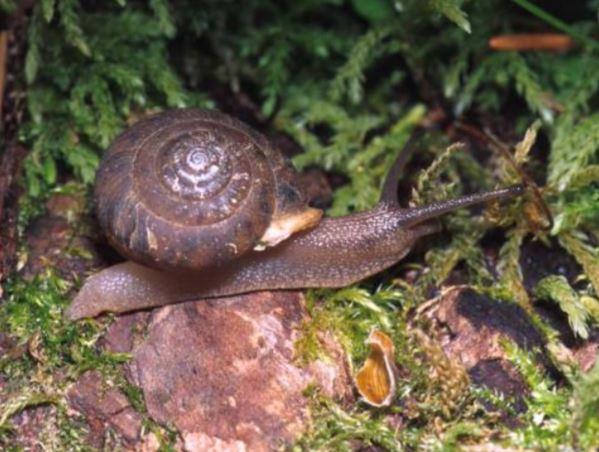Low-
Moderate
The Dalles Hesperian's population size is low and the trend is unknown. These snails are in the Family Polygyridae. Snails in this family are of conservation concern because they have specialized habitat requirements. Snails do not readily disperse and populations are isolated. They are vulnerable to alteration of their habitat.
Description and Range
Physical description
The Dalles hesperian is a terrestrial snail in the family Polygyridae. This species has a thin shell that is dull light brown or tan. The shell measures between 0.55 and 0.6 inches (14 and 15 millimeters) wide and about 0.35 inches (9 millimeters) high, with 5-1/2 to 6 whorls. A whorl is the part of the shell that is one 360-degree section of the spiral. There are rows of short, fine hairs on its spire. The spire consists of all whorls except the body whorl. It can be difficult to identify this species since shell features are similar within the Vespericola genus.
Ecology and life history
The Dalles hesperian is generally found in wet or very moist sites. In dry areas, it is associated with a permanent water source such as a spring or seep. Individuals are entirely terrestrial, but they seek refugia sites where the humidity level is relatively high and temperature is constant, such as deep within cracks in mud, in rock talus or under permanently moist vegetation. This species has been collected from under bark and larger pieces of coarse woody debris. It prefers dense understory.
This species lives approximately three to five years. It reproduces only once in its lifetime. Individuals may breed during their second season. Adults likely lay eggs in very moist locations and protected sites in new or existing flask-shaped nesting holes, or sometimes in pre-existing depressions in soil, moss, and under coarse woody debris, or at the base of vegetation. Juvenile snails hatch approximately eight to nine weeks after oviposition, and they disperse from the nest site within hours of hatching.
Polygyrids are generally herbivorous and fungivorous snails. The Dalles hesperian feeds by scraping algae, yeast, bacteria and diatoms from rock and woody surfaces; they may also consume green plant materials.
These snails may travel several hundred feet during a season, only to return to original refugia sites.
Geographic range
This species has a scattered distribution and has been documented in Oregon in Multnomah, Wasco, Jackson, Sherman, Deschutes, Hood River, Yamhill, and Jefferson Counties. In Washington it has been reported in Klickitat County. No specific information on abundance at these sites is documented.
Climate vulnerability
Sensitivity to climate change
Low-
Moderate
There is limited information on the sensitivity of the Dalles hesperian to climate change. This terrestrial species seeks refugia in locations with high humidity and relatively constant temperature (e.g., rock talus, under moist vegetation, deep in cracks in mud). Activities or events that alter conditions, such as moisture levels, shade, and temperature, may make this species vulnerable.
Exposure to climate change
Moderate
- Increased temperatures
- Reduced soil moisture and/or drought
- Altered fire regimes
Conservation
Conservation Threats and Actions Needed
- Fish and wildlife habitat loss or degradation
- Threat: Road building, disturbance of talus; habitat alteration that creates xeric conditions; need distribution data.
- Action Needed: Delineate and protect sites.
- Agricultural and aquaculture side effects
- Threat: Unsustainable grazing of habitat.
- Action Needed: Install fencing to carefully manage or prohibit livestock access to occupied riparian areas.
- Resource information collection needs
- Threat: Need distribution data.
- Action Needed: Inventory this species.
See the Climate vulnerability section above for more information about the threats posed by climate change to this species.
Resources
References
Applegarth, J. S. 1999. Management Recommendations for Cryptomastix hendersoni, the Columbia Oregonian (land snail) v.20, Section 2, in T. E. Burke, J.S. Applegarth, and T. R. Weasma. Management Recommendations for Survey and Manage Terrestrial Mollusks (v. 2). USFS and BLM.
Burke, T. E. 2013. Land Snails and Slugs of the Pacific Northwest. Oregon State University Press, Corvallis, OR. 344 pp.
Burke, T., J. Applegarth, T. Weasma, and N. Duncan. 1999. Management recommendations for Survey and Manage terrestrial mollusks, ver. 2.0. USDA Forest Service, USDI Bureau of Land Management. Available online at http://www.or.blm.gov/surveyandmanage/MR/TM23Species/m2000-003.htm
COSEWIC. 2013. COSEWIC assessment and status report on the Oregon Forestsnail Allogona townsendiana in Canada. Committee on the Status of Endangered Wildlife in Canada. Ottawa. xii + 87pp. (www.registrelep-sararegistry.gc.ca/default_e.cfm).
Duncan, N. 2009. Vespericola columbianus depressa. Species Fact Sheet. Interagency Special Status/Sensitive Species Program, Forest Service, Bureau of Land Management.
Edworthy, A., K. Steensma, H. Zandberg, and P. Lilley. 2012. Dispersal, home range size and habitat use of an endangered land snail, the Oregon Forestsnail (Allogona townsendiana). Canadian Journal of Zoology 90(7):875–884.
Frest, T. J., and E. J. Johannes. 1995. Interior Columbia Basin Mollusk Species of Special Concern. Final Report, Deixis Consultants, Seattle. Prepared for Interior Columbia Basin Ecosystem Management Project, Walla Walla, WA 362 pp.
Hietala-Henschell, K. 2017. Species fact sheet for Vespericola depressus. Revised by R. Huff and D. Pankratz 2018. USDA Forest Service Region 6 and USDI Bureau of Land Management, Oregon and Washington, 12pp.
Steensma, K. M. M., L. P. Lilley, and H. M. Zandberg. 2009. Life history and habitat requirements of the Oregon forestsnail, Allogona townsendiana (Mollusca, Gastropoda, Pulmonata, Polygyridae), in a British Columbia population. Invertebrate Biology 128:232–242.
USFWS. 2011. Endangered and Threatened Wildlife and Plants: 90-day finding on a petition to list 29 mollusk species as threatened or endangered with critical habitat: proposed rule. Federal Register 76 (No. 193, October 5, 2011): 61826-61853
